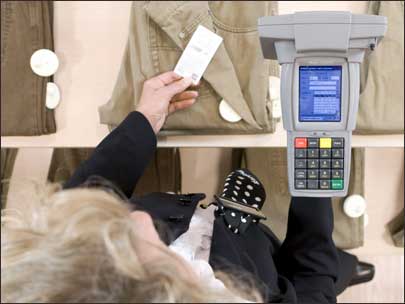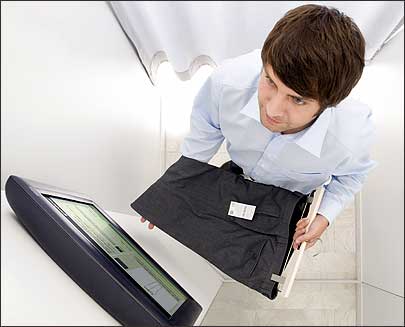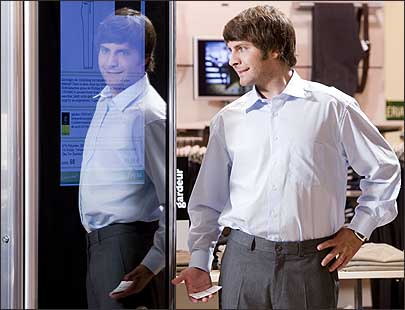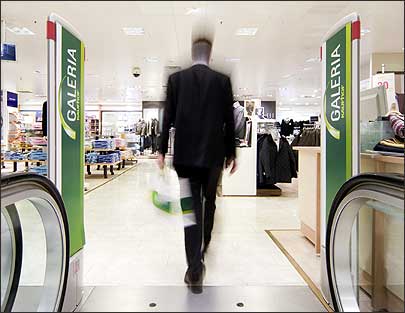Sep 20, 2007Galeria Kaufhof, a division of Metro Group, launched RFID-based shopping services for customers today at its store in Essen, Germany. An entire floor of the department store has been outfitted with Electronic Product Code (EPC) RFID technology, enabling customers to use RFID-enabled dressing rooms and displays and a smart mirror that had previously been available only for demonstration purposes.
On the third floor of the store, in the 2,000-square-meter (6,561-square-foot) men's apparel department, some 30,000 individual articles of clothing and accessories now have hangtags embedded with EPC Gen 2 RFID labels. Approximately 60 RFID interrogators, with a total of more than 100 antennas, capture data from the labels. The tag and interrogator antennas are specifically tuned for near-field operation, shrinking the tags' read range and making the interrogation zone more targeted.
The pilot project is designed to allow Kaufhof to enhance its customer service and increase the availability of its goods due to higher transparency of the goods flow, says Gerd Wolfram, managing director of Metro Group's IT services provider, MGI Metro Group Information Technology.
The store will be able to capture and analyze data, allowing it to determine which garments were tried on together, and if these combinations were actually purchased. It will also be able to observe the impact of the positioning and presentation of goods on the sales floor. For example, do racks of clothes near an escalator sell better—and which racks of items appear overlooked by shoppers? In addition, Metro will be able to assess how long goods take to reach the sales floor, and how long they spend there. "We are filling the data void that exists from the time that products are received until they are sold," Wolfram says.
Partners for the application include Checkpoint Systems, which contributed dual EAS/RFID antennas for security monitoring at the entrances, exits and fitting room areas, as well as point-of-service deactivation, and RFID portals in the store's receiving and stock-room areas; Impinj, which provided RFID interrogators and antennas, in addition to silicon chips used on tags; and Reva Systems, which supplied its Tag Acquisition Processor (TAP) RFID network infrastructure product to enable centralized control and management of Galeria Kaufhof's RFID operations.
The pilot was launched at a press conference in Essen, followed by a demonstration of the four smart dressing rooms, two intelligent shelves, three smart display tables and smart mirror, located in the store's shop devoted to garments made by Gardeur (see Clothing Manufacturer Invests Its ROI in RFID). Metro opted to tag all items sold in its men's department because that is the only department occupying a full floor of the store.

When a shopper brings a pair of pants or other garment into the Gardeur shop's smart dressing room, a near-field UHF RFID interrogator behind the walls recognizes the EPC on the clothing's RFID tag. A flat touch screen inside the dressing room displays additional product information, such as material, price and care instructions.
If the system identifies three garments, the patron can touch the screen to flip through three separate information pages. The display also offers information about other available sizes and colors. Next year, it is expected that the system will make suggestions regarding apparel coordination. For instance, a written description, photograph and video of a matching shirt might be displayed. Metro and Gardeur are working together to create the content that will be displayed, Wolfram says.
Smart displays are intended to help consumers find the proper sizes quickly. When a shopper approaches an RFID-enabled shelf or table containing dozens of folded shirts, he can access the screen to find out if clothing in his neck size and arm length is available, without having to dig through the items. A reader installed on the display interrogates the shirts' RFID tags and updates a list of sizes for that shopper. After trying on a garment, the consumer can approach a smart mirror outside the dressing room, which provides similar information to that provided in the dressing room but does not include a touch screen.
At its regional distribution center in Neuss-Norf, Galeria Kaufhof places the tags on clothing to be sold in the Essen store. Conveyor and packing-table RFID interrogator antennas, provided by Checkpoint Systems, read the garment tags as the tagged apparel is packed or moved along a conveyor belt. Checkpoint UHF dock-door portals read the tags as the garments leave the DC.

Upon arrival at the store in Essen, Checkpoint RFID portals installed in the receiving and stock rooms are used to interrogate the tags and track the garments' locations. As clothes are wheeled on or off the sales floor, or moved in or out of the fitting room area, dual EAS/RFID gates monitor for theft and collect RFID data indicating the their locations.
Clerks hang the garments on the racks, which are also fitted with EPC RFID tags, then use the handheld readers to interrogate the garment tags. A clerk interrogates the rack's RFID tag as well, and instructs the system to associate the rack's tag ID number with those of each garment.
A daily inventory of each rack is performed in the same manner, ensuring that the system has updated information on every item's location. If a customer requires a different size, the clerk can locate the garment on a rack, or in a different dressing room.
Impinj supplied its Speedway interrogators at all in-store fixed read points, with near-field UHF reader antennas installed in smart shelves and on displays. The company's Monza RFID silicon chips were used by UPM Raflatac to make the tags, which RFID label converter Avery Dennison then incorporated into custom garment hangtags bearing the EPCglobal logo and disclosing the use of RFID.
Reva Systems' TAP network infrastructure integrates the RFID system with a variety of applications and back-office programs and systems. "The Reva network infrastructure controls the whole store experience," says Ashley Stephenson, the firm's chairman and cofounder. "People have been tracking items from the shipper to the DC. Now the spotlight is on the retail sales floor."
At the cash register, clerks ring up items in the traditional fashion by scanning the bar codes. At the same time, an RFID interrogator installed under the counter reads the tag in a garment. If an item has been placed on the counter but not purchased, a clerk can use a handheld interrogator to read the RFID tag and inform the system that the garment was not sold after all. By running the bar-code system simultaneously with the RFID application, Metro will be able to obtain data showing if RFID is equally as reliable as bar-code technology, or more or less so.

Metro began working on the project late last year, launching the shop-floor implementation one month ago. One challenge the partners faced was tuning antennas in such a dense-reader environment. "The readers had to be set so each one wouldn't read all the tags," Wolfram says. This problem was solved, in cooperation with Impinj, by employing near-field UHF readers.
Metro shipped pieces of display furniture, along with parts of checkout counters needing to be outfitted with RFID readers, to Impinj's Seattle headquarters, where engineers built custom interrogators and antennas in the lab. By using special near-field UHF antennas for the tags and readers, the company enabled a large number of tags to be read at short range.
Chris Diorio, Impinj's chairman and CTO, says Metro set criteria for the minimum read rate at each read point in the store, based on the importance of that particular read point. The display table, for instance, required a rate of at least 95 percent. "We exceeded all of Metro's established read rates for every reader in the store," Diorio recalls, "with an average rate of more than 99 percent."
According to Wolfram, the pilot will run until at least the end of 2008. During that time, Metro, together with Gardeur and GS1, will analyze the data collected.
The development of the smart mirror, smart shelves and smart dressing rooms in the Gardeur shop was supported through a European research project called BRIDGE (Building Radio frequency IDentification solutions for the Global Environment"—see BRIDGE Project Members Press Ahead). The partners decline to reveal how much they have invested in the project, indicating the amount could not actually be calculated since some devices used are prototypes and not yet priced.
The Metro Group has pioneered the use of RFID in Europe. In a 2003 logistics pilot, Kaufhof tested item-level tagging of Gerry Weber clothing headed for stores in Muenster and Wesel (see Retailer Tests RFID on Garments).


